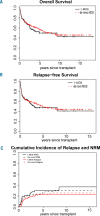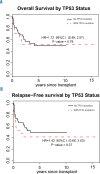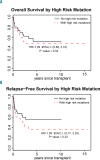Favorable impact of allogeneic stem cell transplantation in patients with therapy-related myelodysplasia regardless of TP53 mutational status
- PMID: 28971906
- PMCID: PMC5709102
- DOI: 10.3324/haematol.2017.172544
Favorable impact of allogeneic stem cell transplantation in patients with therapy-related myelodysplasia regardless of TP53 mutational status
Abstract
Therapy-related myelodysplastic syndrome is a long-term complication of cancer treatment in patients receiving cytotoxic therapy, characterized by high-risk genetics and poor outcomes. Allogeneic hematopoietic cell transplantation is the only potential cure for this disease, but the prognostic impact of pre-transplant genetics and clinical features has not yet been fully characterized. We report here the genetic and clinical characteristics and outcomes of a relatively large cohort of patients with therapy-related myelodysplastic syndrome (n=67) who underwent allogeneic transplantation, comparing these patients to similarly treated patients with de novo disease (n=199). The 5-year overall survival was not different between patients with therapy-related and de novo disease (49.9% versus 53.9%; P=0.61) despite a higher proportion of individuals with an Intermediate-2/High International Prognostic Scoring System classification (59.7% versus 43.7%; P=0.003) and high-risk karyotypes (61.2% versus 30.7%; P<0.01) among the patients with therapy-related disease. In mutational analysis, TP53 alteration was the most common abnormality in patients with therapy-related disease (n=18: 30%). Interestingly, the presence of mutations in TP53 or in any other of the high-risk genes (EZH2, ETV6, RUNX1, ASXL1: n=29: 48%) did not significantly affect either overall survival or relapse-free survival. Allogeneic stem-cell transplantation is, therefore, a curative treatment for patients with therapy-related myelodysplastic syndrome, conferring a similar long-term survival to that of patients with de novo disease despite higher-risk features. While TP53 alteration was the most common mutation in therapy-related myelodysplastic syndrome, the finding was not detrimental in our case-series.
Copyright© 2017 Ferrata Storti Foundation.
Figures




Comment in
-
Transplantation for therapy-related, TP53-mutated myelodysplastic syndrome - not because we can, but because we should.Haematologica. 2017 Dec;102(12):1970-1971. doi: 10.3324/haematol.2017.181180. Haematologica. 2017. PMID: 29192130 Free PMC article. No abstract available.
Similar articles
-
Genetic abnormalities in myelodysplasia and secondary acute myeloid leukemia: impact on outcome of stem cell transplantation.Blood. 2017 Apr 27;129(17):2347-2358. doi: 10.1182/blood-2016-12-754796. Epub 2017 Feb 21. Blood. 2017. PMID: 28223278 Free PMC article.
-
TP53 mutation in allogeneic hematopoietic cell transplantation for de novo myelodysplastic syndrome.Leuk Res. 2018 Nov;74:97-104. doi: 10.1016/j.leukres.2018.10.004. Epub 2018 Oct 11. Leuk Res. 2018. PMID: 30343213 Clinical Trial.
-
Acute myeloid leukemia or myelodysplastic syndrome with chromosome 17 abnormalities and long-term outcomes with or without hematopoietic stem cell transplantation.Leuk Res. 2020 Aug;95:106402. doi: 10.1016/j.leukres.2020.106402. Epub 2020 Jun 18. Leuk Res. 2020. PMID: 32590108
-
Myelodysplastic syndromes: Contemporary review and how we treat.Am J Hematol. 2016 Jan;91(1):76-89. doi: 10.1002/ajh.24253. Am J Hematol. 2016. PMID: 26769228 Review.
-
The prognostic impact of variant allele frequency (VAF) in TP53 mutant patients with MDS: A systematic review and meta-analysis.Eur J Haematol. 2020 Nov;105(5):524-539. doi: 10.1111/ejh.13483. Epub 2020 Jul 27. Eur J Haematol. 2020. PMID: 32621334
Cited by
-
Therapy-Related Myeloid Neoplasms: Complex Interactions among Cytotoxic Therapies, Genetic Factors, and Aberrant Microenvironment.Blood Cancer Discov. 2024 Nov 1;5(6):400-416. doi: 10.1158/2643-3230.BCD-24-0103. Blood Cancer Discov. 2024. PMID: 39422544 Free PMC article. Review.
-
Transplant options and outcomes for TP53 myeloid disease.Hematology Am Soc Hematol Educ Program. 2024 Dec 6;2024(1):335-339. doi: 10.1182/hematology.2024000558. Hematology Am Soc Hematol Educ Program. 2024. PMID: 39644031 Free PMC article. Review.
-
Allogeneic haematopoietic stem cell transplantation with decitabine-containing preconditioning regimen in TP53-mutant myelodysplastic syndromes: A case study.Front Oncol. 2022 Jul 18;12:928324. doi: 10.3389/fonc.2022.928324. eCollection 2022. Front Oncol. 2022. PMID: 35924157 Free PMC article.
-
Transplantation for therapy-related, TP53-mutated myelodysplastic syndrome - not because we can, but because we should.Haematologica. 2017 Dec;102(12):1970-1971. doi: 10.3324/haematol.2017.181180. Haematologica. 2017. PMID: 29192130 Free PMC article. No abstract available.
-
The clinical outcomes of haploidentical stem cell transplantation (haplo-HSCT) for patients with therapy-related myelodysplastic syndrome: comparable to de novo myelodysplastic syndrome.Clin Exp Med. 2024 Feb 8;24(1):33. doi: 10.1007/s10238-023-01287-8. Clin Exp Med. 2024. PMID: 38329593 Free PMC article.
References
-
- Arber DA, Orazi A, Hasserjian R, et al. The 2016 revision to the World Health Organization classification of myeloid neoplasms and acute leukemia. Blood. 2016;127(20):2391–2405. - PubMed
-
- Vardiman JW, Thiele J, Arber DA, et al. The 2008 revision of the World Health Organization (WHO) classification of myeloid neoplasms and acute leukemia: rationale and important changes. Blood. 2009;114(5):937–951. - PubMed
-
- Kayser S, Dohner K, Krauter J, et al. The impact of therapy-related acute myeloid leukemia (AML) on outcome in 2853 adult patients with newly diagnosed AML. Blood. 2011;117(7):2137–2145. - PubMed
Publication types
MeSH terms
Substances
Grants and funding
LinkOut - more resources
Full Text Sources
Other Literature Sources
Medical
Research Materials
Miscellaneous

